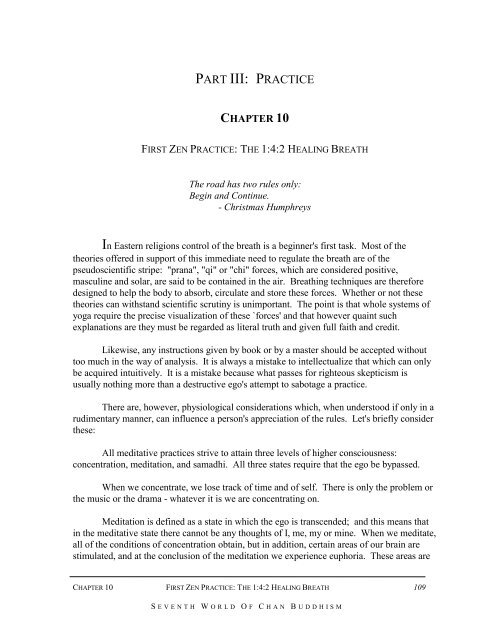seventh world of chan buddhism - Zen Buddhist Order of Hsu Yun
seventh world of chan buddhism - Zen Buddhist Order of Hsu Yun
seventh world of chan buddhism - Zen Buddhist Order of Hsu Yun
You also want an ePaper? Increase the reach of your titles
YUMPU automatically turns print PDFs into web optimized ePapers that Google loves.
PART III: PRACTICE<br />
CHAPTER 10<br />
FIRST ZEN PRACTICE: THE 1:4:2 HEALING BREATH<br />
The road has two rules only:<br />
Begin and Continue.<br />
- Christmas Humphreys<br />
In Eastern religions control <strong>of</strong> the breath is a beginner's first task. Most <strong>of</strong> the<br />
theories <strong>of</strong>fered in support <strong>of</strong> this immediate need to regulate the breath are <strong>of</strong> the<br />
pseudoscientific stripe: "prana", "qi" or "chi" forces, which are considered positive,<br />
masculine and solar, are said to be contained in the air. Breathing techniques are therefore<br />
designed to help the body to absorb, circulate and store these forces. Whether or not these<br />
theories can withstand scientific scrutiny is unimportant. The point is that whole systems <strong>of</strong><br />
yoga require the precise visualization <strong>of</strong> these `forces' and that however quaint such<br />
explanations are they must be regarded as literal truth and given full faith and credit.<br />
Likewise, any instructions given by book or by a master should be accepted without<br />
too much in the way <strong>of</strong> analysis. It is always a mistake to intellectualize that which can only<br />
be acquired intuitively. It is a mistake because what passes for righteous skepticism is<br />
usually nothing more than a destructive ego's attempt to sabotage a practice.<br />
There are, however, physiological considerations which, when understood if only in a<br />
rudimentary manner, can influence a person's appreciation <strong>of</strong> the rules. Let's briefly consider<br />
these:<br />
All meditative practices strive to attain three levels <strong>of</strong> higher consciousness:<br />
concentration, meditation, and samadhi. All three states require that the ego be bypassed.<br />
When we concentrate, we lose track <strong>of</strong> time and <strong>of</strong> self. There is only the problem or<br />
the music or the drama - whatever it is we are concentrating on.<br />
Meditation is defined as a state in which the ego is transcended; and this means that<br />
in the meditative state there cannot be any thoughts <strong>of</strong> I, me, my or mine. When we meditate,<br />
all <strong>of</strong> the conditions <strong>of</strong> concentration obtain, but in addition, certain areas <strong>of</strong> our brain are<br />
stimulated, and at the conclusion <strong>of</strong> the meditation we experience euphoria. These areas are<br />
CHAPTER 10 FIRST ZEN PRACTICE: THE 1:4:2 HEALING BREATH<br />
S EVENTH W ORLD O F C HAN B UDDHISM<br />
109


